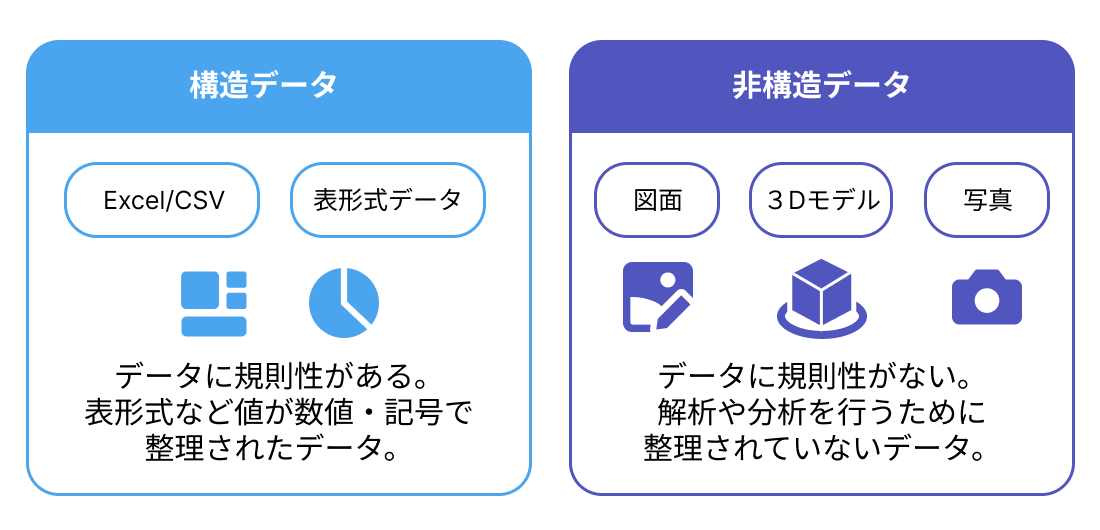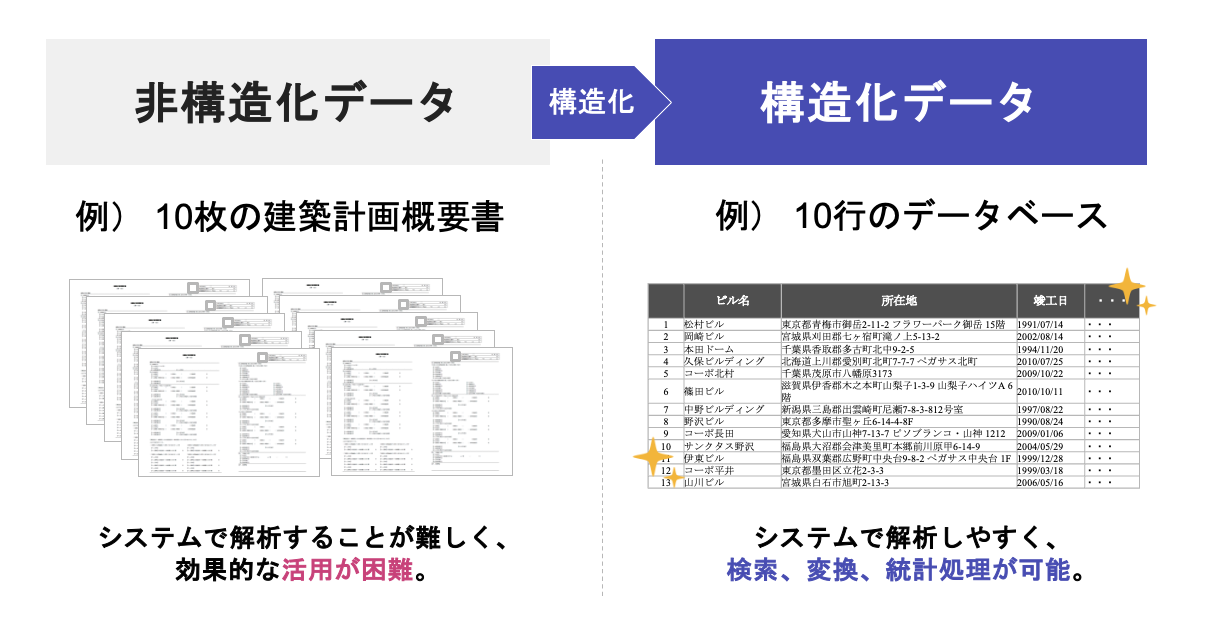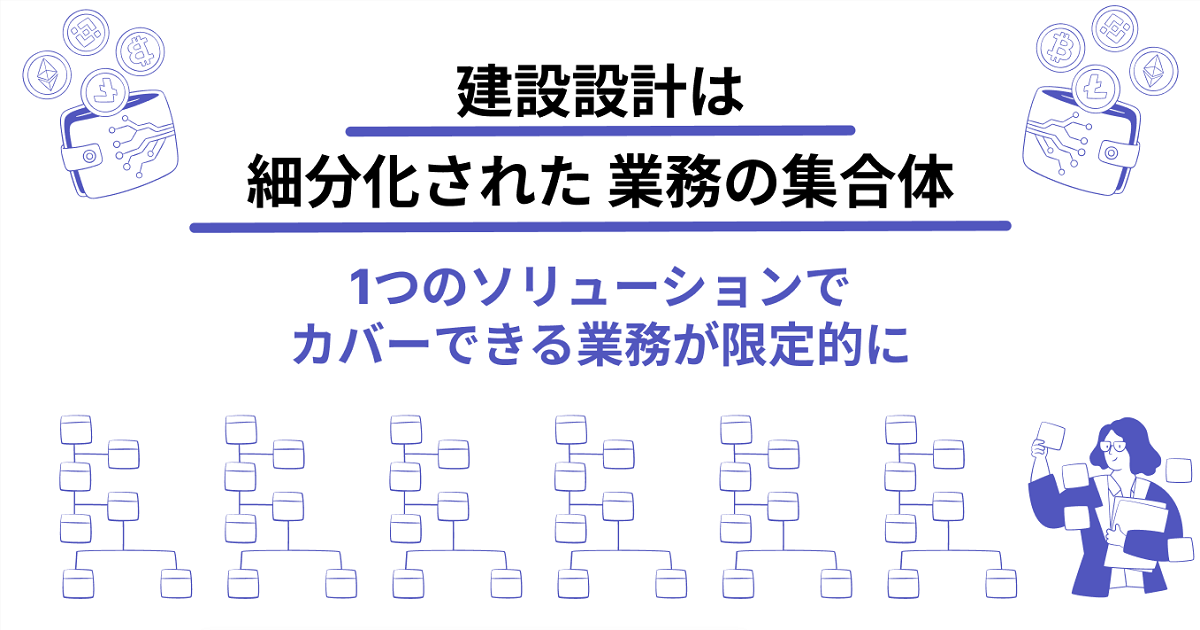
前回の記事では、建設市場で発生する追加費用は年間130兆円以上であることをまとめました。その改善アプローチのひとつには、デジタルを活用した業務改善、つまりデジタルトランスフォーメーション(DX)が考えられます。しかし、様々な分野でDX化が進む昨今においても、建設業、中でも建設設計の分野は、手書きや紙によるプロセスが残存し、DX化が他産業より遅れていると言われている分野です*1*2。建設業の生産性をあげるための新たなソリューション、所謂「建設DX」の遅れは、結果的に建設業界全体の生産性を押し下げ、競争力の喪失という課題を引き起こしています。
建設業界のDXが進まない理由として、建設物理学を専門とするブライアン・ポッター氏が挙げている代表的なものは、オペレーション変更に伴うリスクです*3。建設プロジェクトでは、多くのステークホルダーが関わるため、ワークフローの変更が全体に波及し、予期せぬコストやスケジュールの遅延を引き起こす可能性が指摘されています。
一方で、BIM(ビルディング・インフォメーション・モデリング)やCAD等専門ソフトなど、建設業でもITソフトウェアの導入が進んでいる領域も無くはありません。しかし、専門ソフト同士にはデータの互換性がなく、また全ての関係者が扱うことが難しく、データの利活用やプロジェクト全体でオペレーションの最適化を検討することが難しくなっているのが実情です。
このように、建設プロジェクト全体を通じたDXが進まないことは、複数の要因が絡み合っています。
本記事では、建設DXを促進させるために、建築設計AIソリューションを提供するテクトムだからこその視点で、解決しなくてはいけない建設設計における課題について考察していきます。
企業内に蓄積された活用できていない「非構造化データ」
建設DXを阻む要因として、特に注目すべきなのが「非構造化データ」の存在です。
非構造化データの課題を理解するには、まず「ダークデータ」という概念に触れる必要があります。ダークデータとは、「企業内で価値を生む可能性があるのに活用できていないデータ」のことです。Splunk社 が世界1,300社以上の事業とITの意思決定者を対象に行ったアンケート調査では、回答者の60%が「自社データの半分かそれ以上はダークデータである」とし、回答者の3分の1は「75%以上がダークデータである」と回答していました。そして、建設業界においては、さらにダークデータの割合が多いと予想されます。データとしては存在していても、それが適切に活用されていないダークデータを放置することは、デジタル化や業務効率化の実現を妨げるだけでなく、潜在的な価値を放置していると言っても過言ではありません。

ダークデータとなってしまう要因のひとつが「非構造化データ」の存在です。非構造化データとは、検索、集計、比較などデータの解析や分析を行うために適した構造ではなく、明確な定義がされていないデータのことであり、表形式やデータベースに容易に格納できていないデータを指します。建築業界では、この種のデータが特に多いのが特徴です。例えば、BIMやCAD図面、現場写真、契約ドキュメントなどが挙げられます。これらのデータは形式や内容がそれぞれ異なり、データ同士の互換性や一貫性が確保されていません。

非構造化データの最大の課題は、その取り扱いの難しさです。例えば、2次元図面上で「距離を計測する」といったシンプルな操作でも、始点と終点を特定する必要がありますが、非構造化データのままでは、その特定自体が困難です。また、非構造化データでは、統計処理や検索が極めて非効率的であるため、データ活用の幅が大きく制限されてしまいます。さらに、品質チェックや設計の自動化といった高度な処理は、不可能に近いとさえ言えるのです。
建設業界に眠る非構造化データの問題を克服するには、データの構造化を行う必要があります。しかし、こうした取り組みには時間やコストがかかるため、現時点では大きな課題となっています。過去蓄積されたデータを構造化データにするためには、AIを活用したデータ解析技術の発展が不可欠になるでしょう。

高度な専門家の集まりによる建設設計特有の「専門業務の複雑性」
建設設計プロジェクトは、極めて高度に専門分化された知見の集約によって成り立っています。例えばひとつの、建築設計プロセスを例にとっても、建築家、構造エンジニア、設備エンジニア、ランドスケープデザイナーなど、多くの専門家が連携して作業を進めます。さらに、施工フェーズに進むと、施工管理者、設備施工者、職人など、数十人、数百人以上の専門家が関与し、それぞれの役割を果たすことで、ようやくひとつの建築物が完成します。この高度な専門性が集約していることが、建設業特有の複雑性を生み出しています。

建設業界以外の分野では、特定の専門家の業務を支援するDXソリューションの登場が多く見られます。例えば、医療分野では、AIによる画像診断支援ソリューションが、医療画像を自動的に診断し異常を検知することで、医師の業務負担軽減に寄与しています。しかし、このようなソリューションのほとんどは、高度ではあるが「単体で完結する業務」であり、AIによる代替や支援が比較的容易な領域です。
この文脈においては、建設業界で専門業務を支援するのは、他分野と比べても格段に難しいと言えます。まず、建設業務そのものが非常に複雑で、AIやその他の技術でも理解や支援が困難なことが多いと言えます。例えば、建築設計の美学的な判断や、建設現場での問題が発覚した場合の即興的な解決策などは、単なるAIのアルゴリズムでは対応しきれない領域です。
さらに、複数の専門家がチームとして連携する場合、その難易度はさらに高まります。一人の専門家の業務をDX化するだけでは不十分であり、複数の専門家のニーズに応える統合的なソリューションが求められます。建築設計プロジェクトでは建築家が提案した案を構造エンジニアとともに検証し、設備エンジニアも一緒になりながら実現可能な形に落とし込むといったプロセスが必要となりますが、これを支援するシステムを構築するには、全ての専門領域を包括的に理解し、それぞれを連携させる仕組みが必要です。
このように、建設業界では専門家の個々の業務だけでなく、プロジェクト全体を支援するソリューションが必要となってます。しかし、このようなソリューションを実現するには技術的にも組織的にも多くの障壁があり、現状ではソリューションの開発が進みにくい状況です。この複雑性こそが、建築業界におけるデジタル化の難しさの根幹にあると言えるでしょう。
細分化された業務による「投資対効果」の少なさ
建設設計にDXソリューションを導入するためには、経済的な合理性が欠かせません。その鍵となるのが「投資対効果」です。投資対効果は「投資金額」と「効果」という2つの要素で測られますが、建設設計領域では、この両方に大きな課題を抱えています。これが、建設設計分野でデジタル化をはじめ革新的なソリューションの導入が進みにくい理由の一つです。
まず、投資金額の大きさについてです。前述の「非構造化データ」と「専門家業務の複雑性」が、建築設計に関連するソリューション開発を非常に難しくしています。非構造化データを構造化データに変換および標準化して蓄積・分析していくことや、各専門家業務の理解、そしてそれをAIやIoTなどのデジタル技術によって支援するプロセスの構築には、多大なリソースが必要です。開発の難易度が高い分、プロジェクトのスケールやコストも膨らみ、投資金額が大きくなるのは避けられません。
次に注目すべきは、その「効果の限定性」です。建設設計は非常に細分化された業務の集合体です。一連の業務プロセスを見れば、それは数百から数千の細かなタスクで構成されており、それぞれが特定の専門知識やスキルを必要とします。このため、何か一つのソリューションを導入したとしても、全体の業務効率を大幅に向上させることは難しいのです。仮に1,000個のタスクが存在するとして、そのうち1つのソリューションがカバーできるのはせいぜい1タスク分、つまり全体の0.1%ということも珍しくありません。この状況では、技術的に優れたソリューションであっても、建設設計全体におけるインパクトは限定的となります。投資金額が多額であるにもかかわらず、効果がごく一部に留まるため、結果として投資対効果が低くなってしまいます。このように、技術的な難しさと業務特性が相まって、建築設計分野におけるデジタル化の経済的合理性を損ね、新たなイノベーションの導入を阻害しているのです。

結論として、建築設計分野では、投資金額の大きさと効果の限定性という二重の壁が存在します。この構造的な課題により、DX投資が進みにくい状況が続いていると言えるでしょう。業界全体がDX化のメリットを享受するには、より建設設計業務を通貫する統合的かつ経済的に合理的なアプローチが求められます。
求められる建設DXソリューションとは
前述の通り、「非構造化データ」「多様で複雑な専門家業務」「投資対効果」という3つの要因が絡み合い、建設設計におけるDXソリューションの開発は非常に困難な状況にあります。しかし、建設業界の生産性を高めていくためには、DXによる革新を止めるわけにはいきません。このような状況下で建設業界に求められるソリューションは、以下の特徴を備える必要があります。
1.非構造化データを扱える技術要素
建設業界における過去に蓄積された膨大な非構造化データを整理・分析し、それを活用可能な形に変換する技術が不可欠です。自然言語処理や画像解析、BIMデータの統合処理技術などが鍵となってきます。
2.建設・設計特有の複雑で細分化された専門家業務を支援する高度な推論・論理的思考
建設・設計は、技術的な正確性だけでなく、創造性や推論能力を伴う複雑な業務です。これを支援するには、単なる自動化ではなく、専門家の判断を補完する高度な論理思考モデルや推論エンジンが必要です。例えば、設計案の評価、構造計算の効率化、または施工プロセスの最適化といった領域での支援が考えられます。また、単一の業務ではなく、複数の統合的な業務を支援する必要があります。
3.複数の課題を同時に解決する統合的なプラットフォーム
建設設計は細分化された業務の集積であるため、一つのDXソリューションで全ての課題を解決するのは現実的ではありません。しかし、複数のタスクやフェーズに対応できる統合的なプラットフォームを持てば、部分的な解決策をつなげることで全体効率を向上させる可能性があります。これは結果的に、単体のソリューションを導入するよりも、経済的に合理性が生まれます。
これらの特徴を持つDXソリューションは、建築業界におけるDX化を加速させる鍵となります。
次回以降の記事では、それぞれの要素に焦点を当て、どのような技術やアプローチがこの課題を克服できるのかを掘り下げていきます。非構造化データの革新から専門家業務の支援まで、具体的な解決策の可能性を提示していく予定です。ぜひ次回の記事もご高覧ください。
- McKinsey & Company(2018), How OEMs can seize the high-tech future in agriculture and construction
- Transform Partner, Construction Industry Being Reshaped By Technology
- Brian Potter(2021), Why It’s Hard to Innovate in Construction

